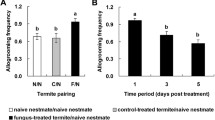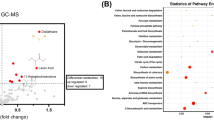Abstract
Active immunization is a crucial colony-level pathogen defense to improve the survival of eusocial termites, which limits the lethal effect of biopesticides for termite control. Here, we report a possible strategy for RNAi-mediated metabolic disorders, which causes reduction in insect pathogen defense and might facilitate the foundation of nontoxic and sustainable pest control methods. Isocitrate dehydrogenase (IDH) was significantly upregulated by active immunization in termites, but its regulatory mechanism has yet to be well understood. We found that dsIDH-injected termites exhibited significantly reduced IDH at mRNA and protein levels and altered levels of isocitrate and NADH, indicating the impaired NAD+-IDH reaction. IDH-silenced termites displayed metabolic disorders, which was implied by significant changes in several metabolites from the carbohydrates and amino acids. When grooming toward fungus-exposed termites, IDH-silenced nestmates showed a significant upregulation of four apoptosis-related genes and caspase 3 activity, and hence the significantly increased rate of apoptosis. These physiological changes led to more apoptotic cell death in different body parts of the nestmates. In particular, more apoptotic cells increased disease susceptibility of the nestmates as revealed by growth of the significantly increased number of colony-forming units from dissected gut contents. Furthermore, the IDH-silenced nestmates exhibited lower antifungal activity and higher mortality, suggesting that IDH downregulation disrupted active immunization against fungal pathogens in termites. These findings illustrated the metabolic regulation of active immunization and provide a sound foundation for enhancing the impact of biopesticides by reducing the pathogen defense of hosts.







Similar content being viewed by others
References
Adams SH (2011) Emerging perspectives on essential amino acid metabolism in obesity and the insulin-resistant state. Adv Nutr 2:445–456
Aliprantis AO et al (1999) Cell activation and apoptosis by bacterial lipoproteins through toll-like receptor-2. Science 285:736–739
Broughton SJ et al (2005) Longer lifespan, altered metabolism, and stress resistance in Drosophila from ablation of cells making insulin-like ligands. Proc Natl Acad Sci USA 102:3105–3110
Bulmer MS, Bachelet I, Raman R, Rosengaus RB, Sasisekharan R (2009) Targeting an antimicrobial effector function in insect immunity as a pest control strategy. Proc Natl Acad Sci USA 106:12652–12657
Cerenius L, Lee BL, Söderhäll K (2008) The proPO-system: pros and cons for its role in invertebrate immunity. Trends Immunol 29:263–271
Chevalier S, Burgess SC, Malloy CR, Gougeon R, Marliss EB, Morais JA (2006) The greater contribution of gluconeogenesis to glucose production in obesity is related to increased whole-body protein catabolism. Diabetes 55:675–681
Chouvenc T, Su NY, Robert A (2009) Inhibition of Metarhizium anisopliae in the alimentary tract of the eastern subterranean termite Reticulitermes flavipes. J Invertebr Pathol 101:130–136
Cremer S, Armitage SA, Schmid-Hempel P (2007) Social immunity. Curr Biol 17:R693–R702
Cremer S, Pull CD, Fürst MA (2018) Social immunity: emergence and evolution of colony-level disease protection. Annu Rev Entomol 63:105–123
Dionne MS, Pham LN, Shirasu-Hiza M, Schneider DS (2006) Akt and foxo dysregulation contribute to infection-induced wasting in Drosophila. Curr Biol 16:1977–1985
Everett H, McFadden G (1999) Apoptosis: an innate immune response to virus infection. Trends Microbiol 7:160–165
Felig P, Wahren J, Sherwin R, Palaiologos G (1977) Amino acid and protein metabolism in diabetes mellitus. Arch Intern Med 137:507–513
Geerlings SE, Hoepelman AI (1999) Immune dysfunction in patients with diabetes mellitus (DM). FEMS Immunol Med Microbiol 26:259–265
Gore DC, Chinkes D, Heggers J, Herndon DN, Wolf SE, Desai M (2001) Association of hyperglycemia with increased mortality after severe burn injury. J Trauma Acute Care Surg 51:540–544
Graves DT, Kayal RA (2008) Diabetic complications and dysregulated innate immunity. Front Biosci 13:1227–1239
Hamilton C, Bulmer MS (2012) Molecular antifungal defenses in subterranean termites: RNA interference reveals in vivo roles of termicins and GNBPs against a naturally encountered pathogen. Dev Comp Immunol 36:372–377
Hiona A et al (2010) Mitochondrial DNA mutations induce mitochondrial dysfunction, apoptosis and sarcopenia in skeletal muscle of mitochondrial DNA mutator mice. PLoS ONE 5:e11468
Hu RG et al (2014) Effect of Lactate accumulation and dichloroacetate on apoptosis of hepatoma cells, expressions of bax, bcl-2 and activity of caspase-3. Progr Mod Biomed 24:4601–4605
Ido Y, Kilo C, Williamson JR (1997) Cytosolic NADH/NAD+, free radicals, and vascular dysfunction in early diabetes mellitus. Diabetologia 40:S115–S117
Kawli T, Tan MW (2008) Neuroendocrine signals modulate the innate immunity of Caenorhabditis elegans through insulin signaling. Nat Immunol 9:1415–1424
Konrad M et al (2012) Social transfer of pathogenic fungus promotes active immunisation in ant colonies. PLoS Biol 10:e1001300
Konrad M et al (2018) Ants avoid superinfections by performing risk-adjusted sanitary care. Proc Natl Acad Sci USA 115:2782–2787
Lamberty M et al (2001) Insect immunity: constitutive expression of a cysteine-rich antifungal and a linear antibacterial peptide in a termite insect. J Biol Chem 276:4085–4092
Leone CW et al (2006) Immunization enhances inflammation and tissue destruction in response to Porphyromonas gingivalis. Infect Immun 74:2286–2292
Liu L, Li GH, Sun PD, Lei CL, Huang QY (2015) Experimental verification and molecular basis of active immunization against fungal pathogens in termites. Sci Rep 5:15106
Liu L, Wang W, Liu YL, Sun PD, Lei CL, Huang QY (2019a) The influence of allogrooming behavior on individual innate immunity in the subterranean termite Reticulitermes chinensis (Isoptera: Rhinotermitidae). J Insect Sci 19:1–6
Liu L, Zhao XY, Tang QB, Lei CL, Huang QY (2019b) The mechanisms of social immunity against fungal infections in eusocial insects. Toxins 11:244
Los M, Wesselborg S, Schulze-Osthoff K (1999) The role of caspases in development, immunity, and apoptotic signal transduction: lessons from knockout mice. Immunity 10:629–639
Lowell BB, Shulman GI (2005) Mitochondrial dysfunction and type 2 diabetes. Science 307:384–387
MacDonald MJ et al (2009) Decreased levels of metabolic enzymes in pancreatic islets of patients with type 2 diabetes. Diabetologia 52:1087–1091
Maechler P, Wollheim CB (2001) Mitochondrial function in normal and diabetic β-cells. Nature 414:807–812
McGettrick AF, O’Neill LAJ (2013) How metabolism generates signals during innate immunity and inflammation. J Biol Chem 288:22893–22898
Michelucci A et al (2013) Immune-responsive gene 1 protein links metabolism to immunity by catalyzing itaconic acid production. Proc Natl Acad Sci USA 110:7820–7825
Mullen AR et al (2011) Reductive carboxylation supports growth in tumour cells with defective mitochondria. Nature 481:385–388
Nation JL (2015) Insect physiology and biochemistry, 3rd edn. CRC Press, Boca Raton
Razvi ES, Welsh RM (1993) Programmed cell death of T lymphocytes during acute viral infection: a mechanism for virus-induced immune deficiency. J Virol 67:5754–5765
Rosengaus RB, Traniello JFA, Bulmer MS (2011) Ecology, behavior and evolution of disease resistance in termites. In: Bignell DE, Roisin Y, Lo N (eds) Biology of termites: a modern synthesis. Springer, Dordrecht, pp 165–191
Ryerson DE, Heath MC (1996) Cleavage of nuclear DNA into oligonucleosomal fragments during cell death induced by fungal infection or by abiotic treatments. Plant Cell 8:393–402
Scaraffia PY, Wells MA (2003) Proline can be utilized as an energy substrate during flight of Aedes aegypti females. J Insect Physiol 49:591–601
Serebrov VV, Gerber ON, Malyarchuk AA, Martemyanov VV, Alekseev AA, Glupov VV (2006) Effect of entomopathogenic fungi on detoxification enzyme activity in greater wax moth Galleria mellonella L. (Lepidoptera, Pyralidae) and role of detoxification enzymes in development of insect resistance to entomopathogenic fungi. Biol Bull 33:581
Susan E (2007) Apoptosis: a review of programmed cell death. Toxicol Pathol 35:495–516
Traniello JFA, Rosengaus RB, Savoie K (2002) The development of immunity in a social insect: evidence for the group facilitation of disease resistance. Proc Natl Acad Sci USA 99:6838–6842
Ugelvig LV, Cremer S (2007) Social prophylaxis: group interaction promotes collective immunity in ant colonies. Curr Biol 17:1967–1971
Yanagawa A, Shimizu S (2007) Resistance of the termite, Coptotermes formosanus Shiraki to Metarhizium anisopliae due to grooming. Biocontrol 52:75–85
Yang C, Fan J, Zhuang Z, Fang Y, Zhang Y, Wang S (2014) The role of NAD(+)-dependent isocitrate dehydrogenase 3 subunit α in AFB1 induced liver lesion. Toxicol Lett 224:371–379
Yoshimi N et al (2016) Cerebrospinal fluid metabolomics identifies a key role of isocitrate dehydrogenase in bipolar disorder: evidence in support of mitochondrial dysfunction hypothesis. Mol Psychiatry 21:1504–1510
Zhang C, Xu MY (2014) The changes of plasma TNF-α and ATP levels in patients with acute craniocerebral injury. Chin J Clin Res 27:404–406
Zhang DX et al (2015) Metabolic reprogramming of cancer-associated fibroblasts by IDH3a downregulation. Cell Rep 10:1335–1348
Zhou XG, Oi FM, Scharf ME (2006) Social exploitation of hexamerin: RNAi reveals a major caste-regulatory factor in termites. Proc Natl Acad Sci USA 103:4499–4504
Zhou XW, Wang XF, Li QZ (2012) Expression and characteristic of the Cu/Zn superoxide dismutase gene from the insect parasitizing fungus Cordyceps militaris. Mol Biol Rep 39:10303–10311
Acknowledgements
We thank Pengdong Sun, Yongyong Gao and Ganghua Li for their assistance with the field collections. We thank Drs. Sylvia Cremer, Barbara Milutinovic and Megan Kutzer for valuable suggestions on an earlier draft of this manuscript. This work was supported by the National Natural Science Foundation of China (31572322) and the Fundamental Research Funds for the Central Universities (2662016PY062).
Author information
Authors and Affiliations
Corresponding author
Ethics declarations
Conflict of interest
The authors declare that they have no conflict of interests.
Additional information
Communicated by E. Quesada-Moraga.
Publisher's Note
Springer Nature remains neutral with regard to jurisdictional claims in published maps and institutional affiliations.
Electronic supplementary material
Below is the link to the electronic supplementary material.
10340_2019_1164_MOESM2_ESM.tif
Fig. S1 Immune responses in the dsIDH-injected naïve termites. (A) IDH silencing had no influence on GNBP1, GNBP2 and termicin expressions in naïve termites. (B) The expression of four apoptosis-related genes was significantly increased in the dsIDH-injected termites as compared to those of the dsGFP-injected termites. The data are shown as the mean ± SEM. *, P < 0.05 (TIFF 980 kb)
10340_2019_1164_MOESM3_ESM.tif
Fig. S2 The dead dsIDH-injected nestmates of the fungus-exposed termites due to infection with the pathogenic fungus M. anisopliae (black scale bar, 1 mm) (TIFF 5713 kb)
Video S1 Five nestmates are grooming toward one fungus-exposed termite in a cell Petri dish (WMV 10207 kb)
Rights and permissions
About this article
Cite this article
Liu, L., Wang, CC., Zhao, XY. et al. Isocitrate dehydrogenase-mediated metabolic disorders disrupt active immunization against fungal pathogens in eusocial termites. J Pest Sci 93, 291–301 (2020). https://doi.org/10.1007/s10340-019-01164-y
Received:
Revised:
Accepted:
Published:
Issue Date:
DOI: https://doi.org/10.1007/s10340-019-01164-y




